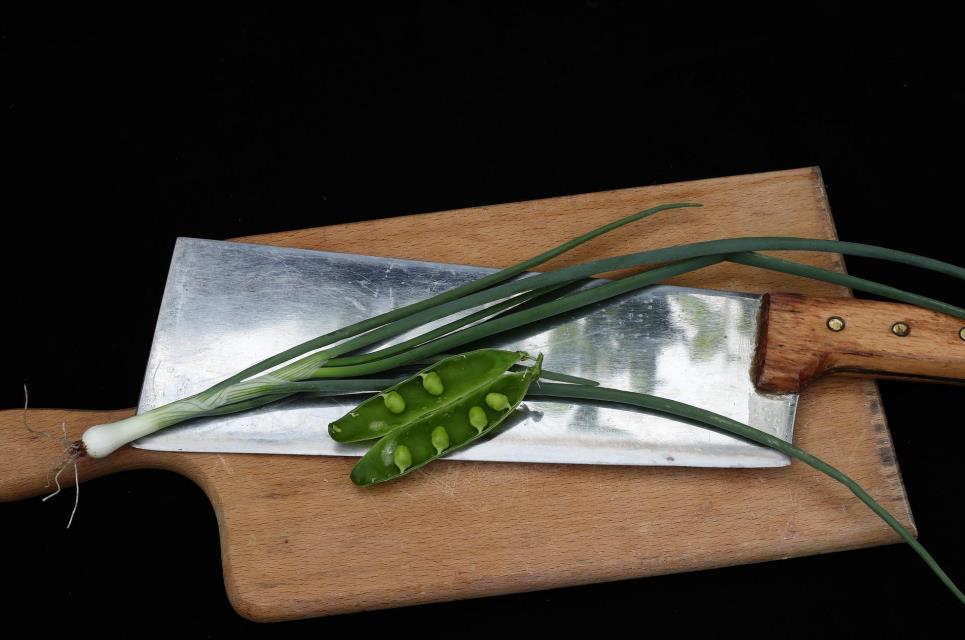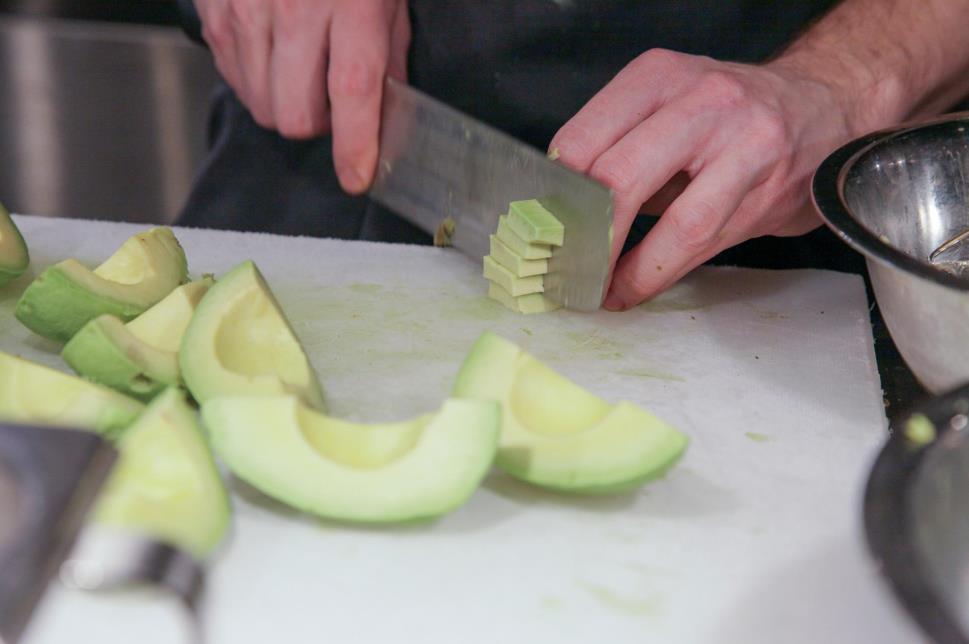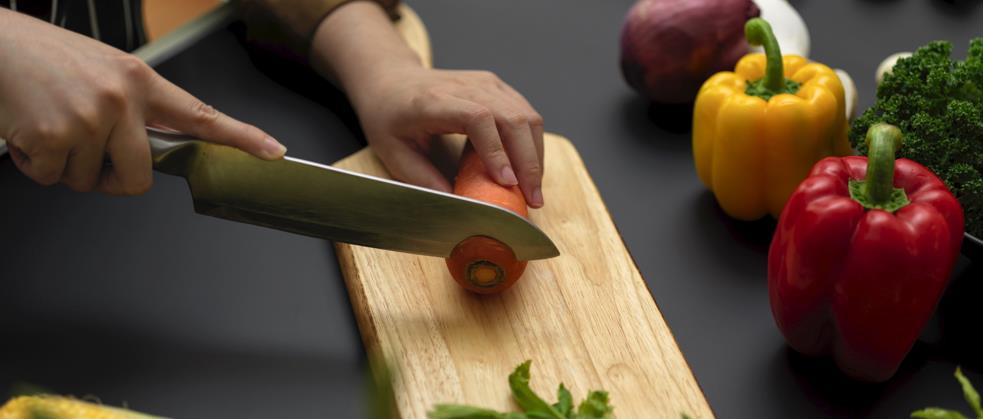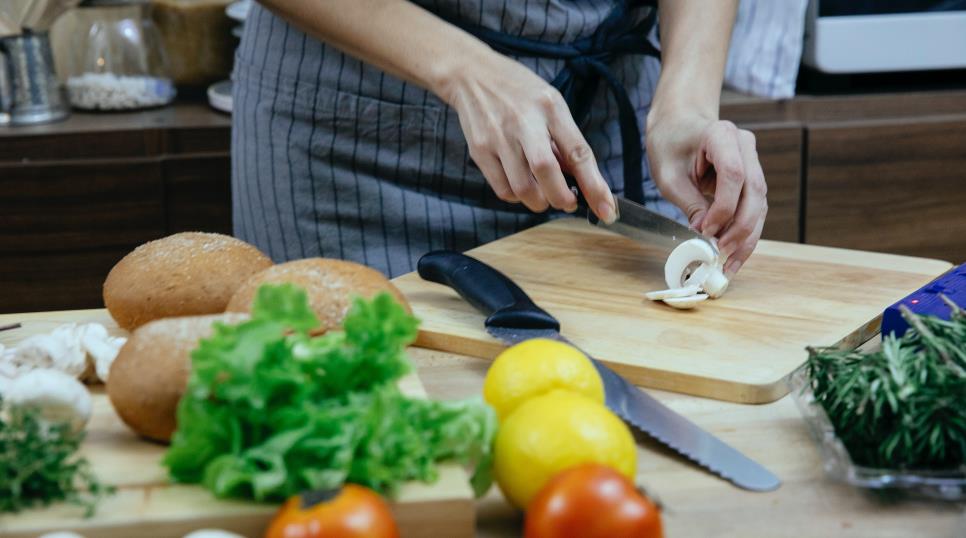Every food prep routine is different. The knife you use to chop garlic might not be the right one for slicing a tomato. And depending on what you’re cooking, you might need a different knife altogether. But two of the most versatile knives in any kitchen are the Chinese cleaver and the chef knife. So which one is better?
The main difference between a Chinese cleaver and a chef knife is the shape of the blade. A Chinese cleaver has a broad rectangular blade with a flat edge, while a chef’s knife is smaller with a curved edge that tapers to a point. Besides the shape, a Chinese cleaver is also heavier and thicker than a chef knife.
The differences in design make each knife better suited for different tasks. This Chinese cleaver vs. chef knife guide will help you decide which one is right for your needs.
Table of contents
What’s a Chinese cleaver?

The best way to describe a Chinese cleaver is “a knife that does it all.” It’s a versatile tool ideal for everything from chopping vegetables to breaking down a chicken.
As the name suggests, the Chinese cleaver originated from China, where it’s still a kitchen staple. However, given its unique design and multi-purpose application, it continues to grow in popularity among chefs worldwide.
Design of a Chinese cleaver
The design of a Chinese cleaver is what makes it so versatile. It has a broad, rectangular blade with a flat edge measuring 6–9 inches long and 4–5 inches wide. The blade is also heavier than most knives, which gives it more heft and makes it better for chopping through tougher ingredients like chicken bones.
While other knives distribute their weight evenly, a Chinese cleaver has most of the weight centered on the blade. The upper edge of the rectangular blade features a full tang that extends into the handle for added strength and durability.
The shape and heft can be intimidating at first, but once you get the hang of using it, you’ll appreciate how easy it is to chop through vegetables and meat.
Uses of a Chinese cleaver
A Chinese cleaver is an all-purpose knife. However, its features make it especially well-suited for certain tasks.

- Slicing: Some Chinese cleavers have a thinner blade, which makes them great for slicing meat, fish, and vegetables. The broad surface also provides a stable cutting platform to make precise cuts.
- Chopping: The broad, rectangular blade and heft of a Chinese cleaver make it ideal for chopping through tougher ingredients like chicken bones and root vegetables.
- Mincing: The flat edge of the blade makes Chinese cleavers excellent for mincing garlic, ginger, and shallots. To mince, hold the ingredient with one hand and chop it with a back-and-forth motion.
- Crushing: You can also use the flat side of the blade to crush garlic or ginger.
- Transferring cut pieces: You can also use the broad surface to transfer chopped vegetables or meat from the cutting board to a pot or pan. Scoop them up and slide them off the blade.
Different types of Chinese cleavers
Chinese cleavers come in three main types:
- Vegetable cleavers
- Meat cleavers
- All-purpose cleavers.
Given the varied features of the different types of Chinese cleavers, it’s important to choose the one that best suits your needs.
- Vegetable cleavers: Also known as Cai Dao, the Chinese vegetable cleaver is one of the most common Chinese kitchen knives. It has a lighter blade with a thinner and sharper edge. While it doesn’t have the heft or power of a meat cleaver, it’s still relatively sturdy and can handle tougher ingredients like squash and sweet potatoes.
- Meat cleavers: The Chinese meat cleaver is the heaviest and most powerful type of Chinese cleaver. Also known as gu dao, the knife gets its name from its ability to chop through bones and other tough meat. It’s much heavier with a thicker blade, which makes it suitable for cutting tougher ingredients.
- All-purpose cleavers: Also known as the chopper knife, the Chinese all-purpose cleaver is a versatile knife that can handle most kitchen tasks. It has a relatively thicker blade than a vegetable cleaver but is not as thick or heavy as a meat cleaver. An all-purpose cleaver is a good option if you want a versatile knife that can handle most kitchen tasks without being too heavy or difficult to use.
What’s a chef’s knife?
A chef’s knife is an all-purpose knife ideal for slicing, dicing, and mincing. Initially, the purpose of the chef’s knife was to disjoint and slice large chunks of meat. Recently, it has become the primary all-purpose kitchen knife used for nearly everything, including slicing vegetables.
Design of a chef’s knife

A chef’s knife features a long broad blade thick at the heel and tapers to a fine point. The belly of the blade curves up towards the tip, making it easy to rock the knife back and forth for a fine chop.
Uses of a chef’s knife
Given the design of a chef’s knife, it’s well-suited for several tasks, including:
- Slicing: The long blade and sharp edge make chef’s knives great for slicing meat, fish, vegetables, and fruit.
- Dicing: The sharp edge and tapering point allow for precise dicing of vegetables.
- Mincing: The broad blade is excellent for mincing garlic, ginger, and herbs.
- Disjointing: The strong bolster and thick heel make it easy to disjoint chicken and other poultry.
Other uses of a chef’s knife include:
- Peeling vegetables like carrots and potatoes
- Cleaving meat from the bone
- Cutting through hard ingredients like squash and pumpkin
Chinese cleaver vs. chef knife
Chinese cleavers and chef knives are all-rounder kitchen knives with versatile designs. You can use either knife for slicing, dicing, and mincing. However, some differences set these knives apart.
Sizes and design
One of the main differences between a Chinese cleaver and a chef knife is the size and design of the blade. The length of a Chinese cleaver is about 6–9 inches long, whereas that of a chef’s knife is 6– 8 inches long. The Chinese cleaver also has a thicker and heavier blade than the chef’s knife.
The design is yet another notable difference. Chinese cleavers have broad rectangular blades, whereas chef knives have a more tapered design. The broad shape makes it easier to transfer chopped ingredients.
The flat edge provides more surface area for mincing garlic and other herbs. Meanwhile, the tapered design of the chef’s knife is ideal for slicing and dicing vegetables.
Cutting techniques

A Chinese cleaver represents a force multiplier. The blade’s weight and the cutting edge’s size make it easier to chop through tough ingredients. When using a Chinese cleaver, the ideal technique is a horizontal chop. This technique is also known as a push cut.
You place the ingredients on the cutting board and chop them down with the blade held horizontally. The broad side of the blade does most of the work, making it easier to chop through tough ingredients.
The curved belly of the chef’s knife makes it perfect for a rocking motion. This technique is ideal for mincing garlic, ginger, and herbs. It’s also great for slicing vegetables. When using a chef’s knife, you hold the blade at a 20 to 30-degree angle and rock it back and forth. The rocking motion moves the blade across the ingredient in a slicing motion.
How to choose between the two?
The best way to choose between a Chinese cleaver and a chef’s knife is to consider your needs and preferences. The features of each knife make them better suited for different tasks.
Both are versatile knives; however, the design construction of the chef’s knife gives it more functions. The tapered blade design and slicing motion make it ideal for many tasks. It’s also a good choice if you have smaller hands because it’s lighter and easier to control.
However, if you’re looking for a knife that can handle more strenuous ingredients, go with a Chinese cleaver. Despite having a steeper learning curve, the extra weight and broad cutting edge make it easier to chop through tough ingredients. It’s also a good choice if you do a lot of mincing because the blade provides more surface area.
Handpicked for you
True cutting power in the palm of your hand
Closing
Choosing between a Chinese cleaver and a chef knife shouldn’t be difficult. Once you have your needs and preferences, you can decide based on each knife’s different features. The above article outlines all you need to know, and we hope you have all it takes to make an educated decision.
Visit our HDMD blog for more detailed information on different knives, their features, and their uses. Consider visiting our HDMD store for a selection of high-quality high-carbon steel knives.












